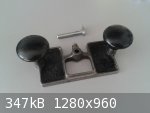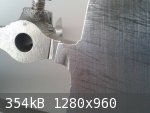antekboodzik
Oud Junkie
    
Posts: 109
Registered: 5-24-2010
Location: north poland
Member Is Offline
|
|
Repairing this old hand router
Hi everyone,
this is probably quite unusual question on this forum, but few forum members are very experienced with metalworking I guess, so I will be happy for
any advice.
Recently I bought this humble, small hand router as a bargain. When I cleaned the sole I found that one arm is broken, or rather snapped in two. I
gogled much about TIG welding and silver and brass brazing. TIG seems to be the easiest way, but can destroy whole casting. And brazing is well
established and accepted method of repairing cast iron objects, but it could be pretty difficult for me to get access to acetylene-/propane-oxygen
torch. And I am not going to buy small propane-oxygen torch for brazing copper pipes, this small router is not worth it.
Anyway, If I can get it welded/brazed, I will probably have to do some preparatory work at my own, so here are few questions:
1. I will have to "vee" groove the seam for welding or brazing - shall I do it on one side (sole or top), or maybe all the way around the broken arm?
Or maybe it is better to "hollow" one side, or drill a shallow hole right into the seam, and then do welding/brazing? Or maybe even separate
everything by filing the seam to have open gap?
2. I have checked, that small butane torch I have got by chance is capable to melt brazing rods for copper. Is it possible I do silver braze with this
torch?
3. I have come to another idea, I am not sure it would work. I can gently "stretch" the castings and make the seam a little "gaped". What if I work
there some tin paste used for tinning/leading repair work on cars, and then heat the area around with that torch to remelt the solder in the seam?
Acctually, you don't use much downward force, when using hand router, so it hasn't to be super strong...
4. Same as above, but what if I can to "stuff" the seam, at least near edges, with leafs of brass or silver "schlagmetal" or Danish leafs, and thet to
heat until it melts?
5. Cyanoacrylate or kwik weld/auto weld? Guys at local home depot store told me that epoxy resin would be the strongest just after welding, and to vee
groove before too. Shall I go to it?


|
|
|
jdowning
Oud Junkie
    
Posts: 3485
Registered: 8-2-2006
Location: Ontario, Canada
Member Is Offline
Mood: No Mood
|
|
I doubt if you would have any success trying to weld or braze the casting.
Why not just drill right through the break (the crack in the centre) and then epoxy a metal rod (diameter a close fit in the hole) into the hole? When
the epoxy glue is fully cured grind the ends of the rod flush with the casting surface. Important to fully degrease the rod and hole before applying
the epoxy.
Good luck.
|
|
|
antekboodzik
Oud Junkie
    
Posts: 109
Registered: 5-24-2010
Location: north poland
Member Is Offline
|
|
I bought once a bench plane with welded (?) side. No problem with it.
This one looks it was welded/brazed too: https://www.olx.pl/oferta/strug-hebel-stanley-made-in-canada-jak-nr-...
If I can't do this I was hoping I could find someone to do welding/brazing to a prepared piece for me.
Anyway, there's enought "meat" I can drill small in diameter hole at an angle to the crack line, and the epoxy a fragment of a nail there...
|
|
|
jdowning
Oud Junkie
    
Posts: 3485
Registered: 8-2-2006
Location: Ontario, Canada
Member Is Offline
Mood: No Mood
|
|
No need to drill across the break at an angle just drill straight through the crack parallel with the fracture surface. This will create a new glue
surface area and the shear strength of the epoxy cement together with the rod will do the rest. It looks like there is sufficient material for
drilling a hole about 3 mm diameter or so for a rod while maintaining some of the casting material either side? The larger the diameter the better
however.
|
|
|
antekboodzik
Oud Junkie
    
Posts: 109
Registered: 5-24-2010
Location: north poland
Member Is Offline
|
|
Thank you for your response. It gives me few ideas.
I have carefully examined the crack an now I can say it is angled itself. So if I drill a hole for a pin paralell to the base just where the arm meets
the rest of body, it will meet the cracking line just somewhere near the middle of the casting. It is going to be easy to do on the drillpress, and to
grind excess afterwards.
But epoxy on woodworking tool? Noooooooo 
How about using a piece of copper wire just like a copper rivet?
Also, I have everything to make homebrew tin paste (Pb free solder, colophony, alcohol), so I can stick copper pin into the hole, pack everything
tight with that paste, heat it and keep fingers crossed it would hold. Anyway, it would be easy reversible...
|
|
|
jdowning
Oud Junkie
    
Posts: 3485
Registered: 8-2-2006
Location: Ontario, Canada
Member Is Offline
Mood: No Mood
|
|
The repair I have suggested using a steel (not copper) rod glued in place with epoxy cement will be a lot stronger and more secure (if properly
executed) than your proposed copper wire/solder approach. Presumably the objective is to fix the crack so that it does not open up or separate in use?
What's the problem you have with using epoxy glue for a small joint repair of metal parts - on woodworking tools or any other similar room temperature
application? Just curious.
|
|
|
antekboodzik
Oud Junkie
    
Posts: 109
Registered: 5-24-2010
Location: north poland
Member Is Offline
|
|
Well, nothing serious at all, but I feel it would be like using PVA glue notoriously in instrument making.
As far as I am aware, it is the best practice in doing repairs of an old and rare items with technologies at least closely related to what was
available, when a particular item was created, and reversible if possible. Also, as the repair can not be hidden in most cases, it should be easy
discernible in a way typical to technology that was used. I don't want to sound overly puristic, but well, don't you think that an elegant, contrasted
brazing or a carefully inserted rivet looks much better than dark, mysterious substance inside the crack line?
And lastly, I am simply very curious about this kind of metalworking 
|
|
|
jdowning
Oud Junkie
    
Posts: 3485
Registered: 8-2-2006
Location: Ontario, Canada
Member Is Offline
Mood: No Mood
|
|
If the tool is a rare artifact then best practice would not be to try to repair it but to conserve - leave it as it is so that it survives as a record
for future researchers. The casting appears to have a few surface defects so is not of good quality to start with.
Epoxy glue is transparent not a dark substance. Are you confusing it with the metal filled epoxy pastes sold in auto shops for 'cold welding' metal
(which would be useless for this application)? The ends of the close fitting steel rod repair would be hardly visible once finished by filing and
polishing level to the surface of the casting. The thin clear epoxy glue line would be practically invisible.
The objective of the rod/glue repair (within, not across) the crack is to provide additional fresh surface area and sufficient tensile/shear strength,
provided by the glue, to prevent the crack from separating in use. The tool is not analogous to a musical instrument where the glue must be reversible
(hot hide glue) to allow for any future internal repairs. This repair should surely be as permanent as possible?
However - don't let my opinion on how best to make the repair discourage you from experimenting to learn and satisfy your curiosity. Good luck with
the repair and I hope it works out well.
|
|
|
antekboodzik
Oud Junkie
    
Posts: 109
Registered: 5-24-2010
Location: north poland
Member Is Offline
|
|
It happens I have got this one:
https://www.tme.eu/en/details/autoweld/glues/cx-80/
It differs from the "Kwikweld" in longer time of set/curing. It is very thick stuff, and it is actually dark grey when fully cured. I did a few
repairs with it with great success, but I stay shy of using it now.
|
|
|
jdowning
Oud Junkie
    
Posts: 3485
Registered: 8-2-2006
Location: Ontario, Canada
Member Is Offline
Mood: No Mood
|
|
That is the 'cold weld' stuff that I was referring to as unsuitable for this repair application. I have used a similar metal filled epoxy putty for
filling holes in metal castings and it works well enough for that.
|
|
|
antekboodzik
Oud Junkie
    
Posts: 109
Registered: 5-24-2010
Location: north poland
Member Is Offline
|
|
Sorry for bombardind you with one question after another, but why, actually, it is unsuitable? Because it is so thick and possibly contains filling
particles, so it will prevent the rod to seat securely, or open the seam?
Ordinary two-agents epoxy is "elastic" a little after curing, doesn't get glass hard, like for example hide/bone glue. Is it bad?
How about anaerobic contact glues fpr metals?
Summarizing, I shall drill a hole from the sole side into the crack line following the plane of the crack (angled a little), and not all the way down,
so the rod will not be seen from top?
|
|
|
jdowning
Oud Junkie
    
Posts: 3485
Registered: 8-2-2006
Location: Ontario, Canada
Member Is Offline
Mood: No Mood
|
|
Yes - the metal filled putty is too thick given that the metal rod should be a close precision fit in the drilled hole. A 'thin' low viscosity glue
is, therefore, required. I have not used them much but air hardening super glues might be OK for the application.
The strength of a repair using synthetic glues will be critically dependent on thorough de-greasing of the joint surfaces to allow proper adhesion.
This might be more difficult but not impossible to accomplish with the 'blind' hole you are proposing (although the crack itself will allow some air
venting of the drilled hole?). Several washes with a de-greasing fluid will likely be required - injecting the fluid into the hole with a small
syringe. Purified white gasoline used in camping stoves is good for de-greasing - or the more hazardous dry cleaning fluid trichlorethylene if it is
not a banned substance these days.
Two part epoxy glues come in various formulations from (relatively) flexible to hard curing. The flexible/elastic type is presumably formulated to
allow gluing of components with differing expansion coefficients (like metal to glass)?
|
|
|